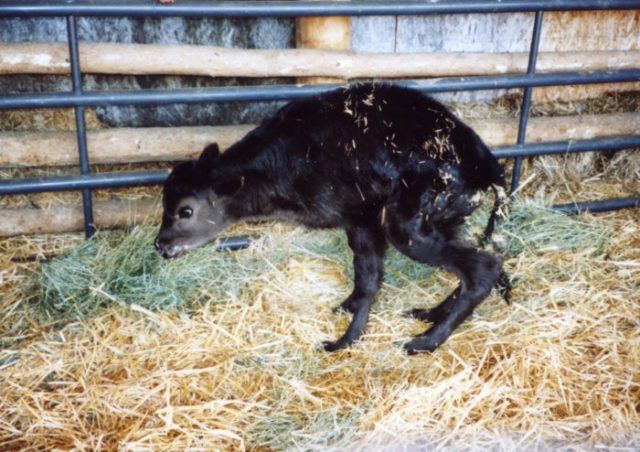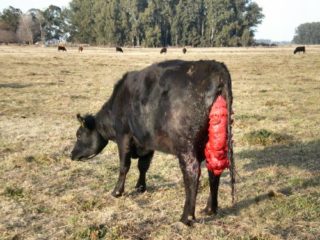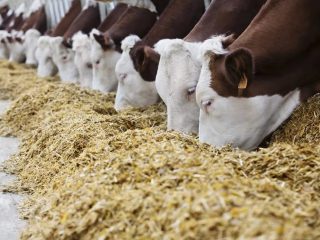Content
Due to improper maintenance and inadequate diet of pedigree farm animals, various non-communicable diseases associated with impaired metabolism or general muscle weakness often overtake. One of these diseases - myopathy or white muscle disease of calves in cattle is very common. Calves are not the only ones suffering from this condition. Myopathy was recorded not only in all types of livestock, but even in poultry.
What is white muscle disease
Myopathy is a non-communicable disease in young animals. Most common in countries with developed animal husbandry:
- Australia;
- USA;
- New Zealand.
Beef from these countries is exported all over the world, but defective feed is used to reduce the cost of production. Such nutrition promotes the growth of muscle mass, but does not provide animals with all the necessary elements.
White muscle disease is characterized by deep structural and functional disorders of the myocardium and skeletal muscles. With the development of the disease, the tissues become discolored.
Myopathy occurs in areas with sandy, peaty and podzolic soils, poor in microelements.
Causes of occurrence
The etiology of myopathy has not yet been studied, although it has been known about it for over 100 years. The main version: lack of micro- and macroelements, as well as vitamins in animal feed. But it has not yet been determined which element should be added to the feed in order to avoid myopathy.
The main version of the occurrence of white muscle disease in young animals is a lack of selenium, vitamin A and protein in the uterus feed. The cub did not receive these substances in the womb and does not receive them after birth. This situation can arise even on free grazing, if there is a lot of sulfur in the soil. This element interferes with the absorption of selenium. If, after the rains, sulfur has dissolved in the soil and the plants have absorbed it, animals may experience a "natural" lack of selenium.
The second version: myopathy occurs when there is a shortage of a whole complex of substances at once:
- Selena;
- iodine;
- cobalt;
- manganese;
- copper;
- vitamins A, B, E;
- amino acids methionine and cysteine.
The leading elements in this complex are selenium and vitamin E.
The course of the disease
The insidiousness of white muscle disease is that its initial stage is invisible. This is when the calf can still be cured. When symptoms become overt, treatment is often useless. Depending on the form, the course of the disease may take more or less time, but development always goes on increasing.
Symptoms of white muscle disease in calves
In the initial period, there are almost no external signs of white muscle disease, except for a rapid pulse and arrhythmia. But few of the owners of cattle every day measure the pulse of a calf. Further, the animal begins to tire quickly and move little. This is sometimes also attributed to a calm nature.
Myopathy is noticed when calves stop getting up and prefer to lie down all the time. By this time, their reflexes and pain sensitivity are noticeably reduced. The previously poor appetite disappears completely. At the same time, salivation and diarrhea begin. Body temperature is still normal, provided there is no bronchopneumonia as a complication. In this case, the temperature rises to 40-41 ° C.
At the last stage of white muscle disease, the calf's pulse becomes weak to a threadlike one, while it increases to 180-200 beats per minute. Observe a pronounced arrhythmia. Shallow breathing with a frequency of 40-60 breaths per minute. Exhaustion is progressing. A blood test shows the presence of vitamin deficiencies A, E, D and hypochromic anemia. The urine of a calf myopathy patient is acidic with a large amount of protein and myochrome pigment.
The symptoms of various forms of myopathy do not fundamentally differ from each other. Only their severity differs.
Sharp form
The acute form is observed in newborn calves. It is distinguished by pronounced symptoms. The duration of white muscle disease in acute form is about a week. If you don't take action right away, the calf will die.
In the acute form, signs of white muscle disease appear very quickly:
- the calf tries to lie down;
- muscle tremors occur;
- gait is disturbed;
- paralysis of the limbs develops;
- breathing is difficult, frequent;
- serous discharge from the nose and eyes.
The work of the digestive tract also begins to stop. Stopping food decomposes in the intestines, producing gas. Outward signs of stopping are bloated bowels and fetid feces.
Subacute forms
The subacute form differs only in more "smoothed" symptoms and a longer course of the disease: 2-4 weeks. The owner has a better chance of noticing something amiss and taking action. Due to this, deaths in the subacute form of myopathy account for 60-70% of the total number of sick calves.
Chronic form
The chronic form of myopathy occurs in calves older than 3 months. This form develops gradually due to an unbalanced diet, in which the necessary elements are present, but in small quantities. Due to mild symptoms, the disease can be triggered before irreversible changes in the muscle structure. In the chronic form, animals are emaciated, inactive and lagging behind in development. Sometimes the hind legs give up in calves.
Diagnostics
The primary lifetime diagnosis is always tentative. It is put on the basis of the enzootic development of the disease and its stationarity. If white muscle disease has always occurred in a given area, then in this case it is also with a high degree of probability. Also, auxiliary signs are the clinical picture and myochrom in the urine.
Modern diagnostic methods also allow for intravital fluoroscopy and electrocardiography. But such studies are too expensive for most farmers, and not all veterinarians can read the results correctly. It's easier to slaughter one or two calves and perform an autopsy.
An accurate diagnosis is made after an autopsy on the basis of characteristic pathological changes:
- softening of the brain;
- swelling of the fiber;
- skeletal muscle dystrophy;
- the presence of discolored spots on the myocardium;
- enlarged lungs and heart.
Calf myopathy is differentiated from other non-communicable diseases:
- rickets;
- hypotrophy;
- dyspepsia.
The case histories here are similar to white muscle disease in calves and stem from an unbalanced diet and improper feeding. But there are also differences.
Rickets has other characteristic manifestations that affect the musculoskeletal system:
- curvature of bones;
- deformation of the joints;
- spinal deformity;
- osteomalacia of the chest.
Rickets are similar to myopathy due to calf exhaustion and gait disturbances.
Symptoms of hypotrophy are similar to white muscle disease in the area of general underdevelopment and weakness of skeletal muscles. But it does not cause irreversible changes in the heart muscle.
With dyspepsia in the calf, the stomach swells, diarrhea, dehydration and general intoxication may occur. Muscle dystrophy is not observed.
Treatment of white muscle disease in calves
If symptoms are recognized in time and treatment for white muscle disease in calves is started early in development, the animal will recover. But if the signs of heart block and myocardial dystrophy are already obvious, treating the calf is useless.
Sick calves are placed in a dry place on a soft bedding and transferred to a milk diet. Also included in the diet:
- quality hay;
- grass;
- bran;
- carrot;
- oatmeal;
- coniferous infusion;
- vitamins A, C and D.
But such a diet, in addition to coniferous infusion, should be common when feeding a calf. Therefore, in the treatment of white muscle disease, this is an important, but not the only complex.
In addition to the diet, additional trace elements are used to treat myopathy:
- subcutaneously 0.1% selenite solution at a dose of 0.1-0.2 ml / kg body weight;
- cobalt chloride 15-20 mg;
- copper sulfate 30-50 mg;
- manganese chloride 8-10 mg;
- vitamin E 400-500 mg daily for 5-7 days;
- methionine and cysteine, 0.1-0.2 g for 3-4 consecutive days.
Instead of giving it with food, vitamin E is sometimes administered as injections of 200-400 mg for 3 consecutive days and another 4 days for 100-200 mg.
In addition to trace elements for myopathy, cardiac drugs are also given:
- cordiamine;
- camphor oil;
- subcutaneous tincture of lily of the valley.
If complications arise, sulfonamides and antibiotics are prescribed.
Forecast
In the early stages of the disease, the prognosis is good, although the calf will lag behind in development and body weight gain. Leaving such animals is impractical. They are raised and slaughtered for meat. With an advanced disease, it is easier and cheaper to score right away. Such a calf will not grow, and in especially severe cases it will die due to irreversible changes in the tissues of the myocardium.
Prevention measures
The basis for the prevention of white muscle disease in calves is the proper maintenance and feeding of animals. The diet of pregnant cows is compiled taking into account local conditions and soil composition. The feed must be balanced. Their composition should contain in sufficient quantity:
- proteins;
- sugar;
- vitamins;
- micro and macro elements.
To ensure the desired composition, the necessary additives are added to the feed mixture. For this reason, feed must be sent periodically for chemical analysis. With systematic analyzes, feed composition can be quickly adjusted.
In disadvantaged areas, queens and offspring are treated with selenite preparations. Cattle are injected subcutaneously with 30-40 mg of 0.1% sodium selenite solution. Injections are started from the second half of pregnancy and repeated every 30-40 days. Stop pricking selenite 2-3 weeks before calving. Calves are injected at 8-15 ml every 20-30 days.
Sometimes it is recommended to use tocopherol together with selenite. In addition, once a day, other missing elements are given (respectively, adults and calves):
- copper sulfate 250 mg and 30 mg;
- cobalt chloride 30-40 mg and 10 mg;
- manganese chloride 50 and 5 mg;
- zinc 240-340 mg and 40-100 mg for calves up to 6 months;
- iodine 4-7 mg and 0.5-4 mg for calves up to 3 months.
The addition of elements is carried out only after the chemical analysis of the feed, since the excess is no less harmful than the deficiency.
Conclusion
White muscle disease in calves in the final stages is incurable. The easiest way to keep your livestock stock is to keep a balanced diet.












